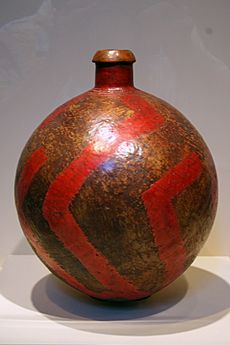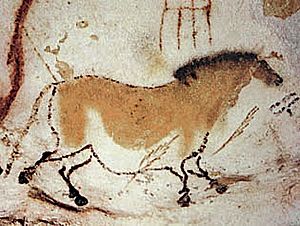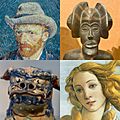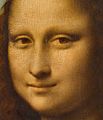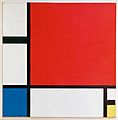Art facts for kids

Art is a way people express themselves creatively. Artists hope their work makes people feel something. It's a way for them to share their feelings and ideas. Many people find art relaxing or inspiring.
Defining art can be tricky, as different people have different ideas. Some believe we create art because of a natural urge to be creative. Art includes many forms like drawing, painting, sculpting, photography, performance art, dance, music, poetry, prose and theatre.
Contents
Different Kinds of Art
Art can be divided into two main types. There are the plastic arts, where something is made, like a painting or sculpture. Then there are the performing arts, where people do something, like dancing or acting.
Art can also be split into pure arts and practical arts. Pure arts are made just for beauty or expression. Practical arts have a purpose, but they also have artistic elements.
- Plastic Arts (Art you can see or touch)
- Performing Arts (Art you experience live)
- Practical Arts (Art with a purpose)
- Culinary Art: This is about creating amazing flavors and tastes through cooking.
- Making Things: This includes designing and building things like architecture, filming, fashion, photography, and even video games.
What Does "Art" Mean?
Some people say that art is anything made to excite our senses. It can also make us think, feel, or see things differently. An artwork is often judged by how much it affects people. It's also about how many people can connect with it and how much it's valued.
One simple way to think of "art" is "arrangement." Art is created when someone arranges things in the world in a new way. For example, an artist might arrange colors on a canvas to make an image or a cool design.
Art is also a powerful way to show emotion. An artist might feel something so strongly that they need to create something to express it. Sometimes, artists create just for themselves. But if others connect with the emotion too, the art can become famous.
A Brief History of Art
Art has been around for a very long time! Some of the oldest art includes sculptures, cave paintings, and rock art. These date back to the Stone Age.
All the great ancient civilizations had their own unique art styles. Think of Ancient Egypt, India, China, Greece, Rome, or Arabia. In the Middle Ages in Europe, much of the art showed people and stories from the Bible. This was seen in paintings, stained glass windows, and mosaics.
Islamic art often features amazing geometric patterns and beautiful Islamic calligraphy. In India and Tibet, people created painted sculptures, dance, and religious paintings. Chinese art includes jade carving, bronze work, pottery, poetry, and painting. Many Chinese art styles are named after the ruling family of the time.
After the Middle Ages in Europe, there was a "Renaissance" (which means "rebirth"). People rediscovered science, and artists could paint more than just religious subjects. Artists like Michelangelo and Leonardo da Vinci still painted religious scenes, but they also painted myths. They also invented perspective. This made things in paintings look smaller when they were further away, which was a new idea!
In the late 1800s, artists in Europe created many new painting styles. These included Classicism, Romanticism, Realism, and Impressionism. The 20th century brought even more styles, such as Expressionism, Fauvism, Cubism, Dada, Surrealism, and Minimalism.
Why Art Matters
In some societies, people believe art belongs to the artist who made it. They think the artist put their "talent" into the art. So, the art is the artist's property.
In other societies, people think art belongs to everyone. They believe that society helped the artist create the work. In this view, society as a collective helped make the art through the artist.
What Art Does for Us

Art has many important roles:
- Learning: Art can teach us about the artist and the world they lived in.
- Beauty: Art can be beautiful and bring us joy and pleasure.
- Thinking: Art makes us think about new ideas, not just everyday life.
- Values: Art can show us what the artist cared about. It can reveal what they liked or disliked in human actions.
- Messages: Artists often use their work to share a message, offer criticism, or even suggest political change.
Related pages
Images for kids
-
Clockwise from upper left: an 1887 self-portrait by Vincent van Gogh; a female ancestor figure by a Chokwe artist; detail from The Birth of Venus (c. 1484–1486) by Sandro Botticelli; and an Okinawan Shisa lion
-
Back of a Renaissance oval basin or dish, in the Metropolitan Museum of Art
-
The stylized signature of Sultan Mahmud II of the Ottoman Empire was written in Islamic calligraphy. It reads "Mahmud Khan son of Abdulhamid is forever victorious".
-
The Great Mosque of Kairouan in Tunisia, also called the Mosque of Uqba, is one of the finest, most significant and best preserved artistic and architectural examples of early great mosques. Dated in its present state from the 9th century, it is the ancestor and model of all the mosques in the western Islamic lands.
-
Painting by Song dynasty artist Ma Lin, circa 1250. 24.8 × 25.2 cm
-
Napoleon I on his Imperial Throne by Ingres (French, 1806), oil on canvas
-
Detail of Leonardo da Vinci's Mona Lisa, c. 1503–1506, showing the painting technique of sfumato
-
A Navajo rug made circa 1880
-
The Metropolitan Museum of Art in Manhattan. Museums are important forums for the display of visual art.
-
The Museum of Art in Basel (Switzerland), is the oldest public museum of art in the world.
-
Composition with Red Blue and Yellow (1930) by Piet Mondrian (Dutch, 1872–1944)
See also
 In Spanish: Arte para niños
In Spanish: Arte para niños


